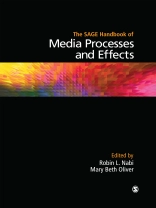The study of media processes and effects is one of the most central to the discipline of communication and encompasses a vast array of theoretical perspectives, methodological tools, and applications to important social contexts. In light of this importance—as well as the rapid changes in the media environment that have occurred during the past 20 years—this Handbook explores where media effects research has been over the past several decades, and, equally important, contemplates where it should go in the years ahead.
COVERAGE
- Part I offers an overview of the field and conceptualizations of media effects, along with a range of quantitative and qualitative methodologies used in the study of media effects.
- Part II focuses on prominent theoretical approaches to the study of media effects from a more societal perspective, tracing their historical contexts, theoretical developments, criticisms and controversies, and the impact of the new media environment on current and future research.
- Part III emphasizes the various factors that influence the critical functions of message selection and processing central to a host of mass media application contexts.
- Part IV reflects a dominant trend in the media effects literature—that of persuasion and learning—and traces related theoretical perspectives through the various contexts in which media may have such effects.
- Part V explores the contexts and audiences that have been traditional foci of media effects research, such as children, violence, body image, and race, addressing the theories most applicable to those contexts.
- Part VI highlights a concern central and unique to the communication discipline—message medium—and how it influences effects ranging from what messages are attended to, how we spend our time, and even how we think.
Innehållsförteckning
PART I. CONCEPTUAL AND METHODOLOGICAL ISSUES
1. A Retrospective and Prospective Look at Media Effects – Jennings Bryant, Dolf Zillmann
2. Conceptualizing the Audience – W. James Potter
3. Quantitative Methods and Causal Inference in Media Effects Research – Itzhak Yanovitzky, Kathryn Greene
4. Qualitative Methods – Thomas R. Lindlof
PART II. SOCIETY, POLITICS, AND CULTURE
5. Cultivation Analysis and Media Effects – Michael Morgan
6. Framing and Agenda Setting – Dhavan V. Shah, Douglas M. Mc Leod, Melissa R. Gotlieb, Nam-Jin Lee
7. The Influence of Presumed Media Influence: Origins and Implications of the Third-Person Perception – Nurit Tal Or, Yariv Tsfati, Albert C. Gunther
8. News and Poliltics – Vincent Price, Lauren Feldman
9. Media Effects and Cultural Studies: A Contentious Relationship – Toby Miller
PART III. MESSAGE SELECTION AND PROCESSING
10. Uses and Gratifications: An Evolving Perspective of Media Effects – Alan M. Rubin
11. Entertainment – Mary Beth Oliver
12. Current Research in Media Priming – David R. Roskos-Ewoldsen, Beverly Roskos-Ewoldsen
13. The Limited Capacity Model of Motivated Mediated Message Processing – Annie Lang
14. Emotion and Media Effects – Robin L. Nabi
15. Mediated Relationships and Media Effects: Parasocial Interaction and Identification – Jonathan Cohen
16. Individual Differences in Media Effects – Marina Krcmar
17. Media Use and the Social Environment – Daniel G. Mc Donald
PART IV. PERSUASION AND LEARNING
18. Theories of Persuasion – Daniel J. O′Keefe
19. Social Cognitive Theory and Media Effects – Frank Pajares, Abby Prestin, Jason Chen, Robin L. Nabi
20. Emerging Issue in Advertising Research – L.J. Shrum, Tina M. Lowrey, Yuping Liu
21. Media Effects and Population Health – K. Viswanath, Sherri Flynt Wallington, Kelly D. Blake
22. Educational Television – Marie-Louise Mares
23. Media Literacy – W. James Potter, Sahara Byrne
PART V. CONTENT AND AUDIENCES
24. Violent Media Effects – Brad J. Bushman, L. Rowell Huesmann, Jodi L. Whitaker
25. Racial/Ethnic Stereotyping and the Media – Dana E. Mastro
26. Media and the Body – Kristen Harrison
27. Media and Sexuality – Jane D. Brown
28. Perceptions of Media Realism and Reality TV – Alice E. Hall
29. The Effects of Viewing Televised Sports – Arthur A. Raney
30. Digital Games – Peter Vorderer, Ute Ritterfeld
31. Children and Adolescents: Distinctive Audiences of Media Content – Barbara J. Wilson, Kristin L. Drogos
PART VI. MEDIUM ISSUES
32. Diffusion of Innovations: Theoretical Extensions – Ronald E. Rice
33. Displacement Effects – Jennings Bryant, Wes Fondren
34. Medium Theory: An Alternative to the Dominant Paradigm of Media Effects – Joshua Meyrowitz
35. The Evolution of Media System Dependency Theory – Sandra J. Ball-Rokeach, Joo-Young Jung
36. Media Effects 2.0: Social and Psychological Effects of Communication Technologies – S. Shyam Sundar
37. The Study of Media Effects in the Era of Internet Communication – Miriam J. Metzger
Om författaren
Mary Beth Oliver (Ph.D., University of Wisconsin, Madison, 1991) is a professor in and co-director of the Media Effects Research Lab in the College of Communications at Penn State University. Her research and teaching focus on media effects, with an emphasis on media entertainment, media and emotion, and media and social cognition. She was a Fulbright Research Scholar in New Zealand and served as Chair of the Mass Communication Division of the National Communication Association. She is co-editor with Jennings Bryant on Media Effects, Advances in Theory and Research (3rd ed.), and is former co-editor of Media Psychology, former associate editor of the Journal of Communication and Communication Theory, and former book-review editor for the Journal of Communication.












